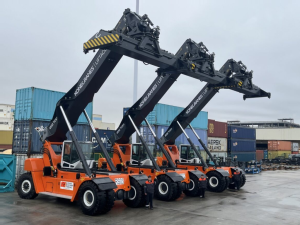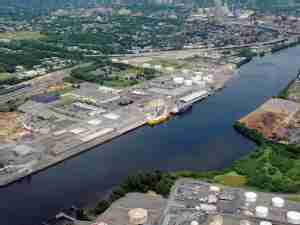Bronx, New York City, NY - City Council Member and Land Use Committee Chair Rafael Salamanca, Bronx Community Board 2 Chair, Bobby Crespo, and members of several Bronx organizations and the local business community joined McInnis Cement executives to celebrate the official opening of the McInnis’ cement terminal in the Bronx, the first new industrial maritime project built on the South Bronx waterfront in more than half a century.
The newly constructed 100,000-square-foot, 24/7 operational terminal is the ideal port location for storing and distributing cement in New York City and beyond. With large ocean vessels sailing from the company’s plant in Port-Daniel—Gascons, Canada to the Bronx, the warehouse on site can store up to 44,000 metric tons of cement, which is the equivalent of 1,500 truckloads. Since 90 percent of the plant’s cement will be delivered via ships, traffic is projected to decrease significantly across bridges and roads, including the Cross-Bronx, Major Deegan, Sheridan and Bruckner Expressways. This is expected to eliminate 25,000 one-way truck trips and remove more than two million truck miles off the roads across the region annually.
“Our Bronx terminal is more than just a new facility. In addition to building a new cement company, our Hunts Point location is reactivating a working waterfront while balancing the needs of the community, environmental habitat and industry,” said Jean Moreau, President and Chief Executive Officer, McInnis Cement. “Our goal was to set a new standard for development in the New York City harbor, placing a major industrial operation in harmony with a natural wildlife habitat and providing waterfront access for the citizens of the South Bronx.”
An integral part of the South Bronx Greenway is the three-acres of wetlands which allows the public to enjoy nature, while preserving the water habitat for plants, birds and fish. To create this habitat, McInnis restored the shoreline, which included removing a century old decayed pier system and installing a wave attenuator to preserve the wetlands and protect the waterfront.
This Hunts Point location has a long history with many uses over the years. Dating back to the 1850s, the site was once a 19th century amusement park as well as a float yard to move rail cars laden with coal, construction materials and daily consumables for transport to Manhattan and Long Island. The site eventually went dormant, fell into disrepair and was used as an illegal city dump for a number of years before being acquired by Steven Smith, a visionary entrepreneur with a concept to bring a part of the South Bronx waterfront back to life. McInnis, along with Smith’s company, Oak Point Property LLC, continued the extensive remediation efforts to transform the multi-acre property into an exemplary industrial site. The site is one of the largest privately-owned public spaces (POPs) in New York.
Additionally, McInnis Cement is the first project to become certified through the Waterfront Alliance’s new, nationally applicable Waterfront Edge Design Guidelines (WEDG). WEDG Certification is the gold standard for resilient, ecologically-sound, and accessible waterfront design. WEDG is an important tool to cut through the myriad challenges—complex ecosystems, overlapping regulatory jurisdictions, multiple stakeholders, sea level rise and coastal storms – providing clear guidance for excellent waterfront design. Used by design professionals and planners, government agencies, and community advocates alike, the free program offers a common language that allows all users to work together toward the highest standards.
In addition to providing environmental benefits, the site is providing new living wage jobs and is generating tax revenue for the state and local governments. The terminal has already created employment opportunities for the Bronx, with several residents – all of whom are veterans – currently working on site. Additionally, the location offers convenient access to a large number of concrete producers, who are located in one of the most densely populated areas of the U.S., and one that features both a vibrant workforce and significant construction activity.
“With the access to efficient waterways, our ships allow us to be environmentally friendly while making deliveries efficiently. This is also an industrially-zoned waterfront site that happens to be in area with a quality workforce as well as in the heart of the largest construction customer base,” said Tony Sneska, Vice President, Marketing & Sales. “While the terminal’s impact on local cement supply, employment, traffic and revitalization might be considered more than enough to justify the ambitious project, its impact on the local environment may prove to be its greatest reward.”









